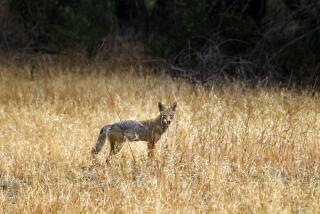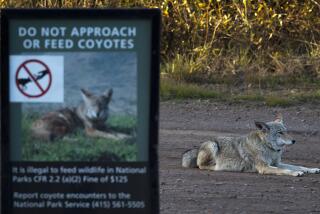The Cost of Coyote Meat in Arizona
- Share via
Here in Arizona, with its tradition of ranching and hunting, most people see coyotes as the enemy. The pressure to “do something” about coyotes has been strong enough to cause various state and federal agencies to invest considerable time and energy in an effort to “control” (i.e. kill) coyotes in the state.
My colleague Gerald Cole, now retired from Arizona State University, caustically examined the economics of these programs in his paper, “Notes on the Cost of Coyote Meat in Arizona.” Using official reports, Cole determined that governmental expenditures in the 1969 campaign to rid the state of 1,864 coyotes totaled more than $150,000, or just under $81 per victim.
These same reports estimated that coyotes destroyed about 1,100 domestic animals, about half of which were sheep, although 17 goats, 3 dogs and cats and 2 horses entered into the tally. Cole wondered out loud whether coyotes could really have been responsible for the deaths of the two horses, but for the purposes of his exercise he accepted the claim that they had. Valuing the three dogs and cats in the account at $14, Cole calculated the total economic loss laid at the jaws of coyotes at $42,225.
It does not require a doctorate in economics to guess that the feds would have come out well ahead in 1969 if they had simply paid ranchers the full market value of the animals supposedly killed by coyotes and let it go at that. This conclusion becomes still more attractive if one accepts Cole’s calculation that the hundreds of coyotes bagged in 1969 by traps, snares, baited cyanide canisters, hunting dogs and bullets would have dispatched approximately 55,000 jack rabbits, had they been permitted to live to perform this service for the ranchers of Arizona. Because 150 jack rabbits consume enough forage to support one cow or five sheep, the coyote carnage in 1969 cost more than $50,000 in lost cattle production.
In the years since Cole examined the cost of coyote meat, the major government agency responsible for coyote killing has changed from the U.S. Fish and Wildlife Service of the Department of Interior to the Animal Damage Control (ADC) unit of the U.S. Department of Agriculture. The ADC claims that 1,530 Arizona coyotes fell in fiscal year 1987 to leg-hold traps, snares, poison and even hunters in helicopters and fixed-wing aircraft.
As in 1969, ADC specialists spent a majority of their effort on coyotes, which constituted three-quarters of the total number of “targeted” animals taken (excluding birds, jack rabbits and small rodents). If we assume that the hunt for large mammals consumed 70% of the nearly half-million-dollar budget of the ADC, then the prorated cost per coyote was more than $215. Considering inflation, the price tag on coyote meat is probably about what it was nearly 20 years ago.
The ADC report places the value of domestic animals verified to have been dispatched by coyotes at less than $54,000. Even with the addition of a $150 loss in watermelons, the total bill is still far below the approximately $300,000 devoted to destroying coyotes in 1987.
One result of the enthusiasm for preventing coyotes from satisfying their fondness for sheep (as the bumper sticker says, “Eat Lamb. One Million Coyotes Can’t Be Wrong”) has been considerable funding for research on a variety of methods to thwart the wily predator. Some exotic techniques have been developed, including the use of certain breeds of guard dog that were employed centuries ago to reduce wolf predation in Europe at a time when there were wolves to worry about there. Other still more avant-garde stratagems for countering coyotes include putting out lamb-meat baits laced with lithium chloride, a substance that induces unpleasant vomiting. The idea here is that a few experiences with the drugged meat will turn coyotes against lamb in all forms for good.
A less forgiving method is to place hollow collars filled with a cyanide-based toxin on tethered lambs. In theory, when a confirmed lamb-eater goes for the jugular of one of these attractively vulnerable victims, it will puncture the collar, receive a deadly dose of toxin and expire on the spot. In practice, this does not happen, because the attackers apparently quickly sense that something is amiss and back off before getting a lethal mouthful.
Nor have other methods proven particularly effective. The ingenuity and tenacity of coyotes are evident in the dimensions of a truly coyote-proof wire fence, which would be at least 66 inches high, topped with a 38-inch perpendicular overhang and bottomed with a 12-inch underground apron. The mesh of the fence would have to be less than 6 inches by 4 inches.
Why are coyotes so devilishly intelligent and so capable of defying humans? One possibility is that their omnivorous life style has resulted in the natural selection--survival--of coyotes of above-average intelligence. Animals that forage for many different kinds of prey items in many different habitats probably gain a reproductive advantage by investing in neuronal circuitry that permits them to solve the great diversity of problems that stand between them and a good meal.
Thus, for example, the birds that seem to possess the kind of intelligence that humans can appreciate (if not approve) are the jays, crows, and ravens. Many of these species occupy a great range of habitats and make their livings eating all manner of living things, including some foods grown by farmers. I note that the ADC had ravens on its hit list in 1987, dispatching nearly 500 that had been feasting on pistachios and apples.
Thanks to the effects of natural selection on the all-purpose coyote, we need not wax too sentimental about them. They can take care of themselves. Not only are they able to put their evolved intelligence to use in dealing with the novel problems generated by canicidal humans, but their great reproductive flexibility complements their behavioral ingenuity.
Coyotes, like many other animals, adjust their reproductive effort in response to changes in the density of their local population. In areas where coyotes are scarce, having been heavily trapped and poisoned, females begin breeding when they are a year old, and the number of pups that an adult produces averages around eight or nine.
In places where humans do not persecute coyotes, the local population density will be higher and competition among coyotes greater. Under these conditions, 1-year-old females wait another year before trying to breed, and the mature females that do reproduce average three or four pups. From a population perspective, coyotes compensate for control programs. If many are killed, the survivors simply step up their reproductive output.
The variation in reproductive rates of young and old females may seem puzzling if we accept that the evolved goal of coyotes is to reproduce maximally. But remember that a young coyote vixen that tries to raise a brood of youngsters in an area filled with older, more experienced, competing females is likely to fail. She may gain little or nothing for her expensive investment inputs if most die of starvation.
Differences in the lifetime reproductive success of individuals, as measured by the number of surviving descendants each produces, is what drives the evolution of a species. Coyotes are the product of this process and females, therefore, are not inclined to make poor investments in reproductive effort. If conditions are bad, individuals wait or cut back.
If the field is open, thanks to human intervention, surviving females quickly fill the void with their progeny, which at least do not have to contend with the cold-hearted competitors of their own kind.
In one sense, the hard work of the ADC in Arizona does constitute a kind of success story. The animal controllers have been able to bag about the same number of coyotes year after year, enabling them to justify their existence to a particular consistency. And yet the coyote population has not really been reduced, despite all the refined techniques that humans have dreamed up to apply to this favored “target species.”
We are a persistent irritant to the coyote world, something that must and will be endured. . . .
More to Read
Sign up for Essential California
The most important California stories and recommendations in your inbox every morning.
You may occasionally receive promotional content from the Los Angeles Times.













